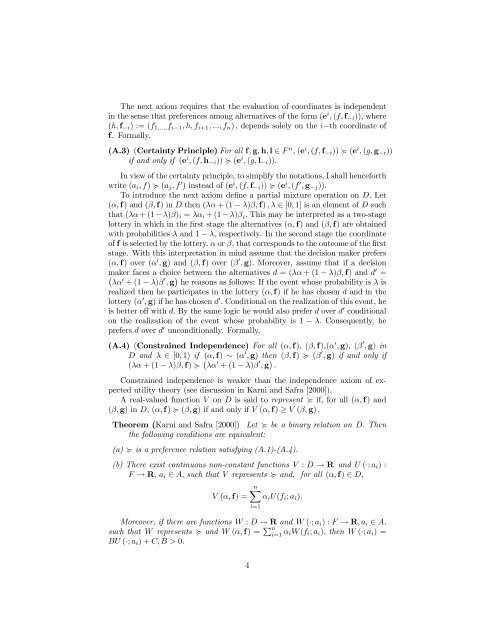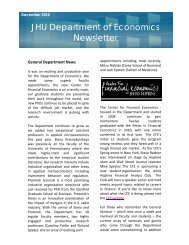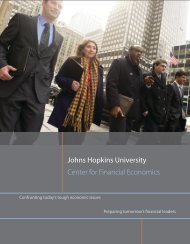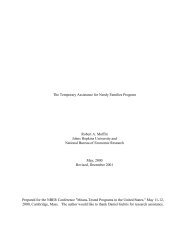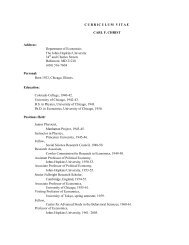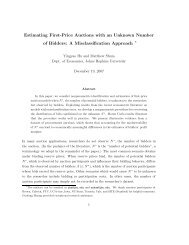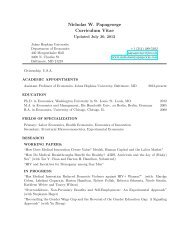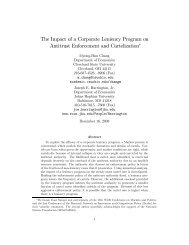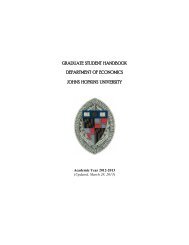Subjective Expected Utility Theory with Costly Actions - Economics ...
Subjective Expected Utility Theory with Costly Actions - Economics ...
Subjective Expected Utility Theory with Costly Actions - Economics ...
Create successful ePaper yourself
Turn your PDF publications into a flip-book with our unique Google optimized e-Paper software.
The next axiom requires that the evaluation of coordinates is independent<br />
in the sense that preferences among alternatives of the form (e i ; (f;f¡i)); where<br />
(h; f¡i) :=(f1;:::;fi¡1;h;fi+1; :::; fn) ; depends solely on the i¡th coordinate of<br />
f. Formally,<br />
(A.3) (Certainty Principle) For all f; g; h; l 2 F n ; (e i ; (f;f¡i)) < (e i ; (g; g¡i))<br />
if and only if (e i ; (f;h¡i)) < (e i ; (g; l¡i)):<br />
In view of the certainty principle, to simplify the notations, I shall henceforth<br />
write (ai;f) < (aj;f 0 ) instead of (e i ; (f;f¡i)) < (e i ; (f 0 ; g¡j)):<br />
To introduce the next axiom de…ne a partial mixture operation on D: Let<br />
(®; f) and (¯;f) in D then (¸® +(1¡ ¸)¯;f) ;¸2 [0; 1] is an element of D such<br />
that (¸® +(1¡ ¸)¯)i = ¸®i +(1¡ ¸)¯ i: This may be interpreted as a two-stage<br />
lottery in which in the …rst stage the alternatives (®; f) and (¯;f) are obtained<br />
<strong>with</strong> probabilities ¸ and 1 ¡ ¸; respectively. In the second stage the coordinate<br />
of f is selected by the lottery, ® or ¯, that corresponds to the outcome of the …rst<br />
stage. With this interpretation in mind assume that the decision maker prefers<br />
(®; f) over (® 0 ; g) and (¯;f) over (¯ 0 ; g): Moreover, assume that if a decision<br />
maker faces a choice between the alternatives d =(¸® +(1¡ ¸)¯;f) and d 0 =<br />
¡ ¸® 0 +(1¡ ¸)¯ 0 ; g ¢ he reasons as follows: If the event whose probability is ¸ is<br />
realized then he participates in the lottery (®; f) if he has chosen d andinthe<br />
lottery (® 0 ; g) if he has chosen d 0 : Conditional on the realization of this event, he<br />
is better o¤ <strong>with</strong> d: Bythesamelogichewouldalsopreferd over d 0 conditional<br />
on the realization of the event whose probability is 1 ¡ ¸: Consequently, he<br />
prefers d over d 0 unconditionally. Formally,<br />
(A.4) (Constrained Independence) For all (®; f), (¯;f),(® 0 ; g), (¯ 0 ; g) in<br />
D and ¸ 2 [0; 1) if (®; f) » (® 0 ; g) then (¯;f) < (¯ 0 ; g) if and only if<br />
(¸® +(1¡ ¸)¯;f) < ¡ ¸® 0 +(1¡ ¸)¯ 0 ; g ¢ :<br />
Constrained independence is weaker than the independence axiom of expected<br />
utility theory (see discussion in Karni and Safra [2000]).<br />
A real-valued function V on D is said to represent < if, for all (®; f) and<br />
(¯;g) in D; (®; f) < (¯;g) if and only if V (®; f) ¸ V (¯;g) :<br />
Theorem (Karni and Safra [2000]) Let < be a binary relation on D. Then<br />
the following conditions are equivalent:<br />
(a) < is a preference relation satisfying (A.1)-(A.4).<br />
(b) There exist continuous non-constant functions V : D ! R and U (¢; ai) :<br />
F ! R; ai2 A, such that V represents < and, for all (®; f) 2 D;<br />
nX<br />
V (®; f) = ®iU(fi; ai):<br />
Moreover, if there are functions W : D ! R and W (¢; ai) :F ! R;ai 2 A;<br />
such that W represents < and W (®; f) = Pn i=1 ®iW (fi; ai); then W (¢; ai) =<br />
BU (¢; ai)+C; B > 0.<br />
4<br />
i=1


